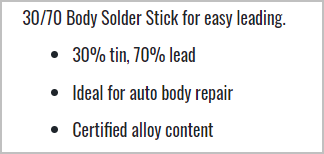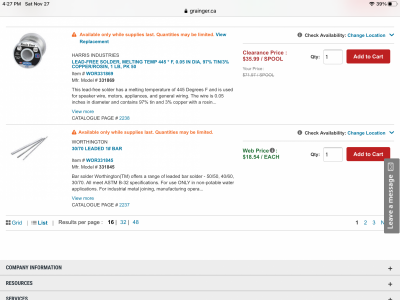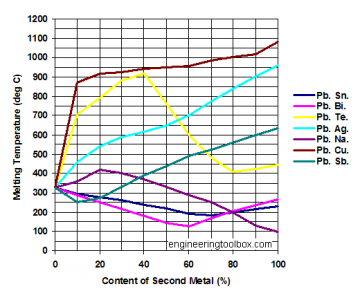You are using an out of date browser. It may not display this or other websites correctly.
You should upgrade or use an alternative browser.
You should upgrade or use an alternative browser.
WTB Low Melt Solder
- Thread starter YotaBota
- Start date
Are you looking for white metal or solder (to join/repair)? My buddy is a model RR guy & I recall him saying the older white metal parts have lead content & now they use a different composition.

 www.mylargescale.com
www.mylargescale.com
If you can find the recipe it might be possible to source from a jewelry supplier if the hobby angle doesn't pan out

White Metal Composition?????
I wish to Cast a few Whitemetal Bogies for a couple of Coaches and Parcel Vans I`m building, Can anyone give me the Composition of Whitemetal please, I have about 2 Kilo`s of Lead laying around and figured on a Homemade Mix to provide some Whitemetal. Any assistance would be...
If you can find the recipe it might be possible to source from a jewelry supplier if the hobby angle doesn't pan out
Amazon was my first go to, they have some low temp solder that might work but it's designed for circuit board repairs. It certainly isn't cheap.
This is something totally new for me so it's a good thing there are extra white metal parts to practice with. All the videos I've seen have related to model railroading so I may search out those guys. I might try melting a scrap piece and see what temp it takes to melt down. The kit is from the 60's ish so it probably does contain a lot of lead.
Babbitt - no experience with this, I know it's used as bearing material but no idea how it would work for modeling.
Thanks for the ideas, I'll finish the Stuart 10V before starting the Hubley so there is still lots of time for research.
I'm looking to join/repair and fill seams in the car body and parts. There are a bunch of youtubes showing the process but the solder they use is in what looks like a small brick.Are you looking for white metal or solder (to join/repair)
This is something totally new for me so it's a good thing there are extra white metal parts to practice with. All the videos I've seen have related to model railroading so I may search out those guys. I might try melting a scrap piece and see what temp it takes to melt down. The kit is from the 60's ish so it probably does contain a lot of lead.
Babbitt - no experience with this, I know it's used as bearing material but no idea how it would work for modeling.
Thanks for the ideas, I'll finish the Stuart 10V before starting the Hubley so there is still lots of time for research.
Might be others like this if it helps mitigate buying sticks. I suspect the right alloy (and flux) is very important to success in terms of wetting & adhering the joint.
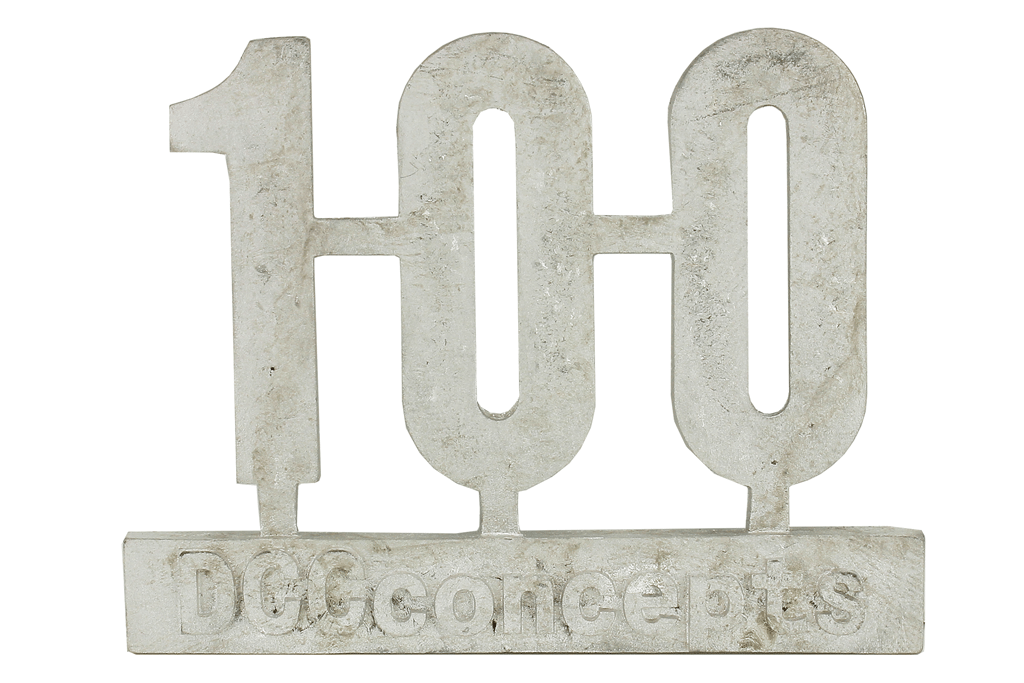

Are you sure the small brick isn't pure lead? That's how they used to do panel repairs in cars in the old days—they had a brick of lead they melted and smoothed on the panel. Maybe they use the the same technique on models?Amazon was my first go to, they have some low temp solder that might work but it's designed for circuit board repairs. It certainly isn't cheap.
I'm looking to join/repair and fill seams in the car body and parts. There are a bunch of youtubes showing the process but the solder they use is in what looks like a small brick.
This is something totally new for me so it's a good thing there are extra white metal parts to practice with. All the videos I've seen have related to model railroading so I may search out those guys. I might try melting a scrap piece and see what temp it takes to melt down. The kit is from the 60's ish so it probably does contain a lot of lead.
Babbitt - no experience with this, I know it's used as bearing material but no idea how it would work for modeling.
Thanks for the ideas, I'll finish the Stuart 10V before starting the Hubley so there is still lots of time for research.
Last edited:
I know those old school sticks you're referring to PT. They may have been a mix of other alloys but according to specs pure lead melts at 327C.
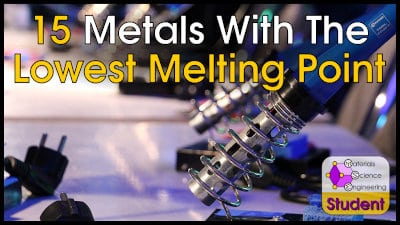
 msestudent.com
msestudent.com
Made me wonder what Cerrobend (Woods metal) was made of. Melts at 158F (70C). Which is interesting given the composition & their respective melting points. Does that make sense?
 www.industrialmetalsupply.com
www.industrialmetalsupply.com

15 Metals With The Lowest Melting Point | Materials Science & Engineering Student
15 lowest melting point metals: Mercury, Francium, Cesium, Gallium, Rubidium, Potassium, Sodium, Indium, Lithium, Tin, Polonium, Bismuth, Thallium, Cadmium, Lead.
Made me wonder what Cerrobend (Woods metal) was made of. Melts at 158F (70C). Which is interesting given the composition & their respective melting points. Does that make sense?
Cerrobend Ingots | Wood’s Metal Ingots | Metal Ingots
I think you are correct. I'm trying to find a YouTube video from years ago where there were using one of these sticks and they talked about the composition. They were chopping down a Mercury '49, so I was probably focused on the car. The guy using it was 1000 years old I think.I know those old school sticks you're referring to PT. They may have been a mix of other alloys but according to specs pure lead melts at 327C.

15 Metals With The Lowest Melting Point | Materials Science & Engineering Student
15 lowest melting point metals: Mercury, Francium, Cesium, Gallium, Rubidium, Potassium, Sodium, Indium, Lithium, Tin, Polonium, Bismuth, Thallium, Cadmium, Lead.msestudent.com
Made me wonder what Cerrobend (Woods metal) was made of. Melts at 158F (70C). Which is interesting given the composition & their respective melting points. Does that make sense?
Cerrobend Ingots | Wood’s Metal Ingots | Metal Ingots
www.industrialmetalsupply.com
Last edited:
This stuff maybe: https://www.eastwood.com/search/?q=lead body solder stick
"Lead Sled", haven't heard that term for a while but that is essentially what I'd be doing.
At about 12 seconds into this video it shows the "bar" of solder that I was looking at trying to find.
The UK has a number of sources for the stuff but I haven't seen anything here in Canada.
I'll dig into Cerrabend more, it may also be an option.
At about 12 seconds into this video it shows the "bar" of solder that I was looking at trying to find.
I'll dig into Cerrabend more, it may also be an option.
Cerrabend might work but I wonder on a hot summer day if it could sag like cooking eggs on a sidewalk. Of course buying the Cerrabend/Shipping will probably have got you the actual solder! Lol Have you tried melting lead with tin yet? It shouldn’t be that hard I’m not sure what the composition is for lead weight for fishing due to the Environmental people maybe try the roofing people for lead flashing.
"Lead Sled", haven't heard that term for a while but that is essentially what I'd be doing.
At about 12 seconds into this video it shows the "bar" of solder that I was looking at trying to find.
The UK has a number of sources for the stuff but I haven't seen anything here in Canada.
I'll dig into Cerrabend more, it may also be an option.
Might be able to use "Cerrasafe" too. It's similar to Cerrabend - might even be the same. It's claim to fame is casting to determine precise dimensions. You pour it hot, as it cools it shrinks smaller than original so it comes out easy, then as it cools more it returns to the original dimension within half a tenth for small ID's. Amazing stuff when you think about it.
I have a few ingots of it.
I've never used Cerrobend myself. I was able to dodge the bullet & managed to bend my radial engine induction tubes without it. But when I was reading up on it, I got the impression it doesn't really stick aggressively to metal surfaces. People melt it in all kinds of containers, even used cooking pots. Then after tube bending, they just heat the part in boiling water & out flows the Cerrobend core. Not that your model will be subjected to elevated temperatures, but typically fluxes go hand in hand with any solder for chemical cleaning/etching. I think Cerrobend is also used for temporary potting of parts, basically in-situ fixtures. So maybe another indication it may not be a great 'bonder' of metals? OT OH maybe they use a release agent or oil in those cases, not sure.
Maybe see if @Chris Cramer knows more about this topic of low melt solder and suppliers. I think he's a jewelry guy.


